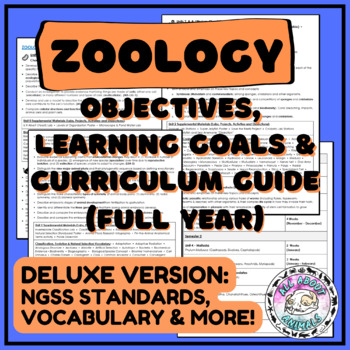Zoology Objectives I Learning Goals I Curriculum Pacing Guide I Deluxe Version
- Zip
Description
Zoology Objectives I Learning Goals I Curriculum Pacing Guide
9 PAGE DETAILED, FULL LENGTH, EDITABLE zoology teacher resource to help you plan & design a full year high school Zoology course - aligned to NGSS - whether this is your first time teaching Zoology or you have already been teaching this course! This resource document includes a detailed overview of a two semester (full year) Zoology class that covers units over each of the 9 major animal phyla ( Porifera I Cnidaria I Platyhelminthes I Nematoda I Annelida I Mollusca I Arthropoda I Echinodermata I Chordata ) & the 5 major groups of vertebrates ( fish I amphibians I reptiles I birds I mammals ) that is aligned to NGSS Life Science (Biology) Standards.
Included in this product: (Deluxe Version)
▪️ 9 Page Document: Zoology Objectives/Learning Goals, Biology Standards, Unit Vocabulary, List of Supplementary Materials/Projects/Labs/Dissections, Content Emphasis/Key Topics & Curriculum Pacing Guide
▪️ Includes a detailed list & breakdown of Zoology units for a full year
▪️ Includes detailed student learning goals & objectives for each Zoology unit
▪️ Includes detailed & labeled aligned NGSS Life Science (Biology) Standards that relate & apply to Zoology learning goals & objectives for each Zoology unit
▪️ Includes a detailed list of key topics & content emphasis for each Zoology unit
▪️ Includes a detailed list of vocabulary for each Zoology unit
▪️ Includes a list of supplementary materials/projects/labs/dissections for each zoology unit (these are lessons I have created/used in my Zoology classes & will eventually have these available to purchase on my TPT store)
▪️ Includes a curriculum pacing guide for a full year of Zoology (Semester 1 & 2)
PDF & WORD (EDITABLE) DOCUMENT COPIES
⭐ Basic (Free) Version DOES NOT Include: NGSS Aligned Life Science (Biology) Standards, Vocabulary Lists & Content Emphasis/Key Topics, Supplementary Materials/Projects/Labs/Dissections Lists


